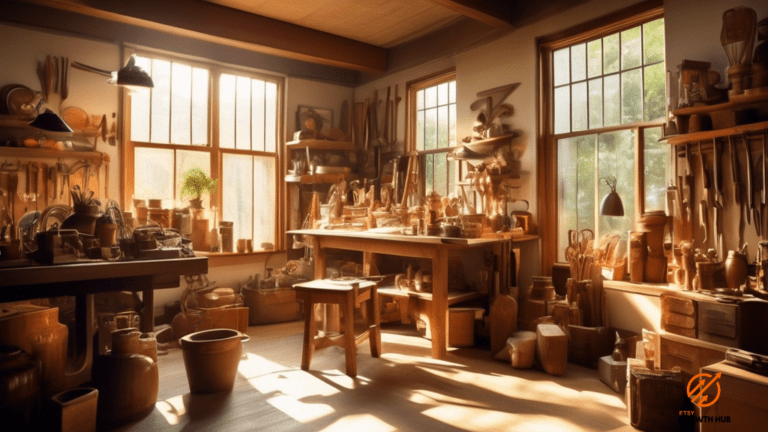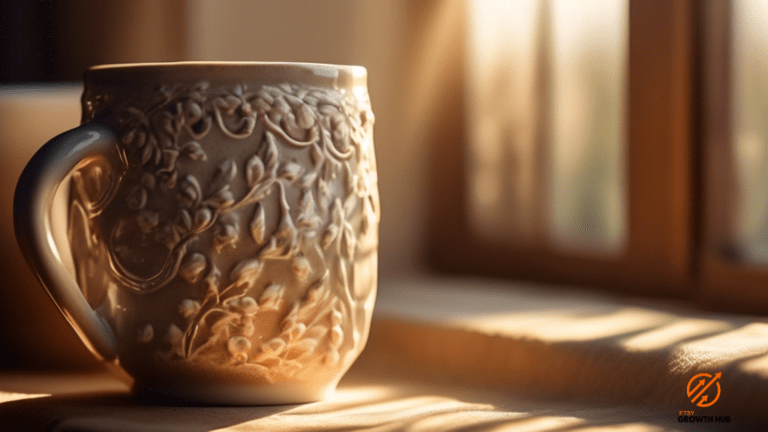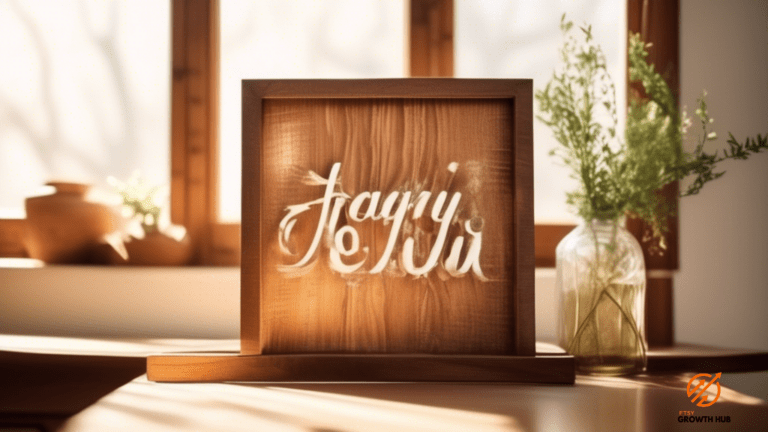Are you a creative soul who loves to make handmade home decor items? Do you often wonder how to price your creations effectively?
Look no further! In this article, we will guide you through the process of setting competitive prices for your handmade home decor items. By following these steps and strategies, you can ensure that your pricing is not only fair to you but also appealing to your customers.
The first step in determining effective pricing is identifying the cost of materials. Take a moment to calculate the expenses incurred in purchasing the materials needed to create your home decor items. From paints and fabrics to wood and glue, every little detail adds up.
By understanding the cost of materials, you can establish a baseline for your pricing, ensuring that you are not underpricing your creations. So, grab a pen and paper and start jotting down the cost of each material used in your handmade home decor items.
Key Takeaways
- Lowering initial prices can attract customers and help penetrate the market.
- Offering lower prices than competitors can entice customers to try your creations.
- Gradually increasing prices after establishing a customer base and gaining recognition is recommended.
- Pricing is a dynamic process that requires adjustments over time based on market insights and customer preferences.
Identifying the Cost of Materials
To determine the cost of materials for your handmade home decor items, you can start by calculating the average cost of materials per item based on your previous purchases. This will give you a better understanding of your expenses and help you make informed pricing decisions.
Did you know that, according to a survey conducted by a home decor industry association, the average cost of materials accounts for approximately 40% of the total production cost for handmade home decor items?
By keeping track of your material costs for each item you create, you can calculate the average cost per item. This involves adding up the total amount you spent on materials for a specific time period, such as a month or a year, and then dividing that total by the number of items you produced during that time. This will give you a rough estimate of how much you are spending on materials for each item.
By understanding this cost, you can ensure that you are pricing your handmade home decor items in a way that covers your expenses and allows you to make a profit.
Calculating the cost of materials is an essential step in effective pricing for your handmade home decor items. It allows you to have a clear picture of your expenses and ensures that you are not underpricing your products. By knowing the average cost of materials per item, you can make informed decisions about pricing, taking into account factors such as labor, overhead costs, and desired profit margin.
Remember, accurately pricing your items will not only help you cover your costs but also ensure that you are adequately compensated for your time and effort in creating beautiful handmade home decor pieces.
Calculating Time and Labor
Calculating the time and effort put into crafting your beautiful home decor pieces is essential for determining their value. As a handmade artist, it’s important to consider the hours you spend creating each item and the labor involved.
Here are four key factors to consider when calculating the time and labor:
- Design and Planning: The time spent brainstorming ideas, sketching designs, and planning the construction process should be taken into account. This initial stage is crucial in creating unique and well-thought-out pieces.
- Material Preparation: Whether it’s cutting fabric, sanding wood, or preparing clay, the time spent getting your materials ready should be factored into the overall labor. This step may involve measuring, cutting, and prepping the materials to ensure they’re ready for assembly.
- Assembly and Construction: This is the most time-consuming part of the process, where you bring all the elements together to create the final product. The time spent assembling, gluing, sewing, or painting should be carefully calculated to reflect the effort put into each piece.
- Finishing Touches: The final touches, such as adding decorative elements, applying finishes, or packaging the item, also require time and attention. These details contribute to the overall quality and appeal of your home decor pieces.
By considering these factors and accurately calculating the time and labor involved, you can determine the true value of your handmade home decor items. This’ll help you set prices that reflect the effort you put into each piece and ensure that your business is sustainable and profitable.
Researching Market Demand
When researching market demand, you’ll need to gather information on what customers are looking for in the home decor industry.
Start by identifying your target market and understanding their preferences and needs.
Look for trends and popular styles in home decor by visiting local home decor stores, attending trade shows, and browsing online marketplaces. Pay attention to the colors, materials, and themes that are in high demand.
Additionally, you can conduct surveys or interviews with potential customers to get direct feedback on their preferences. Ask them about their favorite home decor styles, their budget for purchasing home decor items, and any specific needs or desires they have for their living spaces.
This will help you tailor your handmade home decor items to meet their expectations and increase your chances of success in the market.
In conclusion, researching market demand is crucial for effective pricing of your handmade home decor items. By understanding what customers are looking for in the home decor industry, you can create products that will appeal to your target market and set prices that reflect the value they perceive.
Stay updated on the latest trends, gather feedback from potential customers, and adapt your offerings accordingly.
This way, you can maximize your chances of success in the competitive home decor market.
Setting Competitive Prices
Setting competitive prices is crucial for attracting customers and staying ahead in the market. When it comes to pricing your handmade home decor items, it’s important to strike a balance between affordability and profitability.
Start by researching the prices of similar products in the market to get an idea of what customers are willing to pay. Look at both online and offline platforms to gather a comprehensive understanding of the market.
Once you have an idea of the price range, consider the unique value that your handmade items provide. Are they made with high-quality materials? Do they feature intricate designs or personalized touches? These factors can justify a slightly higher price point. However, it’s important to also consider your target audience and their purchasing power. If your target market consists of budget-conscious customers, you may need to price your items more competitively to attract their attention.
In addition to market research and considering the value of your products, it’s also important to factor in your production costs and desired profit margin. Calculate the cost of materials, packaging, labor, and any other expenses involved in creating your handmade items. This will help you determine a baseline price that covers your costs and allows for a reasonable profit.
Remember to regularly review and adjust your prices as the market and your costs may change over time. By setting competitive prices that align with market demand and your production costs, you can attract customers and ensure the sustainability of your handmade home decor business.
Implementing Pricing Strategies
Crafting a strategy for pricing your unique creations can be as intricate as weaving a tapestry. However, with the right approach, you can ensure that your handmade home decor items are priced effectively and attractively.
Here are four pricing strategies to consider:
- Cost-Plus Pricing: This strategy involves calculating the total cost of producing an item and then adding a markup to determine the selling price. By factoring in all the expenses, such as materials, labor, and overhead costs, you can ensure that you cover your expenses and make a profit. This method is straightforward and ensures that you don’t sell your items at a loss.
- Value-Based Pricing: With this strategy, you determine the price based on the perceived value of your creations to your target market. Consider factors such as the uniqueness, quality, and craftsmanship of your items. If your creations are highly sought after and offer a one-of-a-kind aesthetic, you can price them higher to reflect their value. This strategy allows you to capture the premium that customers are willing to pay for your unique creations.
- Competitor-Based Pricing: This strategy involves analyzing the prices of similar home decor items offered by your competitors and setting your prices accordingly. If you offer a similar product but at a lower price, you can attract price-conscious customers. On the other hand, if your creations are of superior quality or have unique features, you can price them higher than your competitors to differentiate yourself in the market.
- Penetration Pricing: This strategy involves setting a low initial price for your home decor items to penetrate the market and attract customers. By offering a lower price than your competitors, you can entice customers to try your creations. Once you have established a customer base and gained recognition, you can gradually increase your prices. This strategy is particularly effective for new businesses looking to gain market share and build a loyal customer following.
By considering these pricing strategies and evaluating their suitability for your unique creations, you can effectively price your handmade home decor items and maximize your profitability. Remember, pricing is a dynamic process, and it may require adjustments over time as you gain market insights and learn more about your customers’ preferences.
Frequently Asked Questions
How can I effectively handle pricing for limited edition or one-of-a-kind home decor items?
To effectively handle pricing for limited edition or one-of-a-kind home decor items, consider factors like material costs, time invested, uniqueness, and market demand. Research similar products, calculate expenses, and set a fair price that reflects the value of your craftsmanship.
Are there any specific pricing considerations for seasonal or holiday-themed home decor items?
When pricing seasonal or holiday-themed home decor items, consider the extra demand during those times. Take into account the uniqueness and limited availability of these items, allowing you to adjust the price accordingly.
What factors should I consider when pricing wholesale or bulk orders of my handmade home decor items?
When pricing wholesale or bulk orders of your handmade home decor items, consider factors like material costs, labor, overhead expenses, and desired profit margin. Remember, just as a tree needs strong roots to thrive, a well-calculated pricing strategy is the foundation of a successful business.
How can I strategically price my handmade home decor items to cater to different target markets or customer segments?
To strategically price your handmade home decor items for different customer segments, consider factors like market demand, production costs, and competitor prices. Tailor your pricing by offering discounts, bundles, or premium options to cater to specific target markets.
Are there any pricing strategies or techniques that can help me optimize my profit margins without compromising on the quality of my handmade home decor items?
To optimize profit margins without compromising quality, consider value-based pricing. Research your target markets to understand their willingness to pay. Focus on unique features and craftsmanship to justify higher prices.
Last Updated: January 22, 2024
Disclosure: We may receive affiliate compensation for some of the links in this article at no additional cost to you if you decide to purchase a product. You can read our affiliate disclosure in our privacy policy.
Kevin Fairbanks is your expert navigator in the world of Etsy business. With a passion for creativity and a deep understanding of the e-commerce landscape, Kevin brings a wealth of knowledge to aspiring and established Etsy sellers alike.
As a seasoned entrepreneur and successful owner of multiple Etsy shops, Kevin knows firsthand the challenges and triumphs of the Etsy marketplace. His journey is one of innovation, perseverance, and a keen eye for market trends, making him an invaluable guide for anyone looking to succeed on Etsy.
Kevin’s expertise extends beyond just shop management; he is adept in areas such as SEO optimization, effective marketing strategies, and financial planning for online businesses. His insights are grounded in real-world experience, offering practical and actionable advice.
Join Kevin as he shares his journey and expertise on Etsy Growth Hub. Whether you’re starting your first Etsy shop or looking to expand your existing business, Kevin’s guidance is designed to help you navigate the complexities of Etsy selling with confidence and creativity.
Stay tuned with Kevin’s latest strategies and tips on Etsy Growth Hub to transform your passion into a thriving online business. His dedication to empowering Etsy sellers is evident in every piece of advice he shares, helping you turn your Etsy dreams into reality.
Verified and Approved by:

Kevin Fairbanks
Head of SEO
Like This Article?
Share with your friends
Table of Contents
Latest Articles
Keep Reading
-
Strategies For Pricing Your Handmade Vintage Items
Learn the best strategies for pricing your unique vintage items and start earning a profit today! Unleash your inner entrepreneur and click here to discover the secrets of successful handmade pricing.
-
Importance Of Product Reviews On Etsy
Unlock the secret to Etsy success with our in-depth guide on the importance of product reviews. Boost your sales and click here to learn how!
-
Building A Strong Brand For Your Etsy Shop
Boost your Etsy shop sales and stand out with our guide to building a strong brand. Unlock the secrets of successful Etsy branding and start thriving today!




